10 Common Mistakes Everyone Makes When Cooking Spam
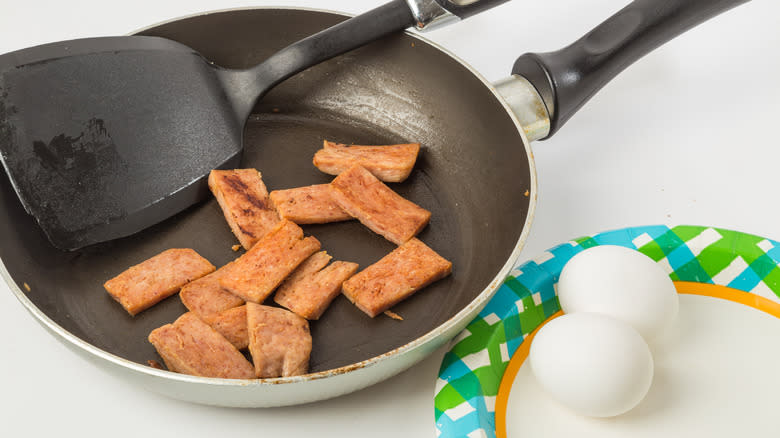
Spam gets a bad rap. A lot of people make fun of it because of its retro-looking tin can and the myth so many Spam-haters believe about it being made up of a bunch of unidentifiable meat scraps (truthfully, it's just pork shoulder and ham). But Spam is actually pretty awesome. It's highly versatile and can be used in a wide variety of dishes ... but only if you cook it correctly.
One of the main reasons people write off Spam and its many recipes is that sometimes, it doesn't turn out well when cooked. It can be mushy or taste salty as all get-out. When things go really wrong, it can even end up boring or bland, especially when compared to a burger or a pizza. This is due to such flubs as overcrowding the pan, improper cutting, and even cooking Spam in its own can. But it doesn't have to be this way. In this article, we're taking a look at some of the most common mistakes people make when cooking Spam, so that you can give this mighty little canned meat the chance -- and respect -- it so rightfully deserves.
Read more: 11 Things You Didn't Know You Should Be Doing With Bacon
Mistake: Cutting Your Spam Too Thick
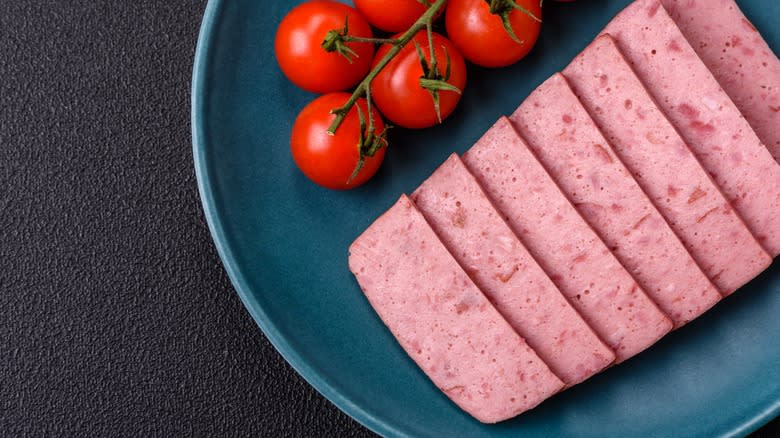
Since it was invented in 1937, Spam has come in a rectangular metal can. This made it perfect for soldiers to tote around during World War II and the Korean War, and it makes it perfect in your pantry today. To cook it, though, you have to remove the meat from the can and cut it into slices, strips, chunks, or whatever shape inspires you. Easy, right?
Not exactly. You can technically cut Spam into whatever thickness you like, but it won't all cook the same. Thinner slices cook faster, so you need to keep an eye on them, but thicker slices may be even more problematic. If your chunks of spam are too big, they'll cook on the outside, but not on the inside. To correct this problem, it's tempting to just cook it longer ... which leads to a burnt exterior and an interior that is most likely still not totally cooked.
Worse than this, though, may be cutting your slices into different thicknesses. Since they'll all require different cooking times, you may end up with a pan of half-burnt, half-cold Spam on your hands. To avoid all of these issues, simply avoid cutting your slices too thick, and make sure all the slices (or cubes, or strips) are as uniform as possible.
Mistake: Overcrowding The Pan
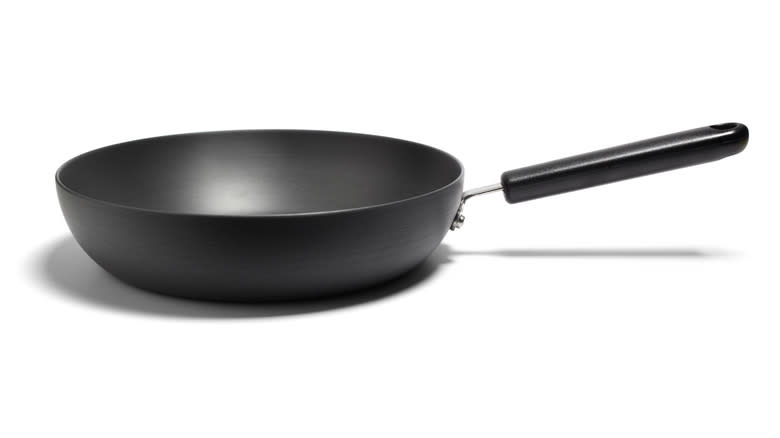
If you've ever had your Spam turn out mushy instead of crisp and firm, there's a major chance you overcrowded the pan. While Spam might not be a food that grows or expands when you cook it, it still needs room to cook.
In fact, pretty much everything you cook needs space if you want it to get that crispy golden brown exterior and juicy interior we all love. The reason why has to do with the heat of the pan. Yes, the pan may be hot because it's over the heat source on the stove, but its temperature changes when food is added. Specifically, it cools down. The more chunks of Spam you put in it, the lower its temperature gets. This leads to the meat sticking to the pan and keeps the moisture inside the Spam from being released, because it isn't seared properly on the outside.
So, instead of trying to pack all your Spam into one pan, you have two choices. One, you can cook your Spam in batches, giving each group of slices or chunks the space and time it needs. Or two, you can simply use a larger pan. In either case, try to make one even layer on the bottom of the pan, not a pile, and you'll see that it cooks properly.
Mistake: Not Heating Up The Pan First

The most popular way to cook Spam is to fry it in a bit of oil. But, like with all things, this is a bit more complicated than it seems. One cannot simply just pour in the oil, toss in some Spam chunks, and go. There is a better way.
To get crispier, golden brown Spam, you need to heat up the oil in the pan first, just as you would if you were deep frying. In this case, you are using much less oil, but the principle is the same: When the Spam hits the pan, it should be hot. This heat sears the meat on the outside, making it crisp while keeping the moisture locked inside, leading to a juicy, well-cooked Spam slice.
If you don't like waiting around for the pan to heat up, you can use this pre-heating time to cut the Spam into slices, making sure to keep them uniform and not too thick. Once the pan is hot, then you can toss in the chunks and go.
Mistake: Thinking You Have To Live With All That Salt
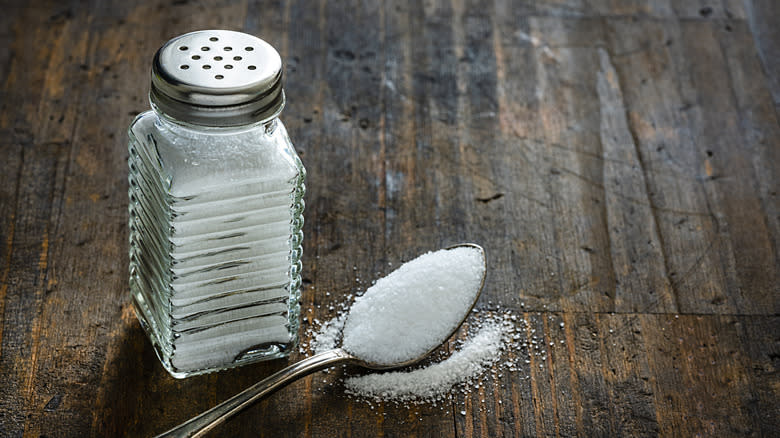
Another common complaint from Spam detractors is that it is too salty. They're not totally wrong: There is a whopping 790 milligrams of sodium in each 56-gram serving of classic Spam, which is 33% of the recommended daily value. But don't let that scare you off. If that sodium level worries you, there are a few things you can do about it.
The first thing you can do is buy lower-sodium Spam. This type of Spam contains 25% less sodium than the original version. You can use it in all of the same recipes and you won't be missing out on that trademark Spam taste.
If that's not enough of a reduction in sodium, you can also rinse the Spam with water before cooking it to remove the salt from the exterior of the product (just be sure to pat it dry with a paper towel before frying it). Boiling it may remove even more salt, but only if you cut it into small pieces. This can even be used as the primary cooking method, resulting in a softer Spam that is perfect for sandwiches.
Mistake: Not Soaking Up Excess Oil
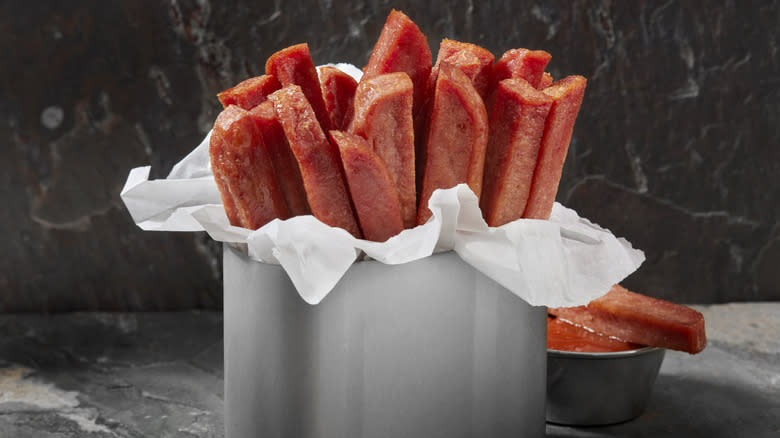
While you're probably not deep-frying Spam on a regular basis, there's a strong chance you do fry it in a bit of oil. This makes for a tasty, crispy slice of Spam, but only if you remember to drain off any excess oil when you're done. If you don't dry the Spam before piling it up on a plate, the remaining oil on its surface can seep into the meat and make it soggy, undoing the lovely frying you just did. It can also add an extra taste and a general oiliness to the meat, which isn't really ideal.
To avoid this problem, you can simply place your Spam on a plate with a paper towel on it as soon as it comes out of the pan. The paper towel will absorb the excess oil and you'll be good to go. If you want to make the meat even more crisp and dry, you can transfer it to a wire rack to let it air out before serving.
Mistake: Thinking Frying Is Your Only Option
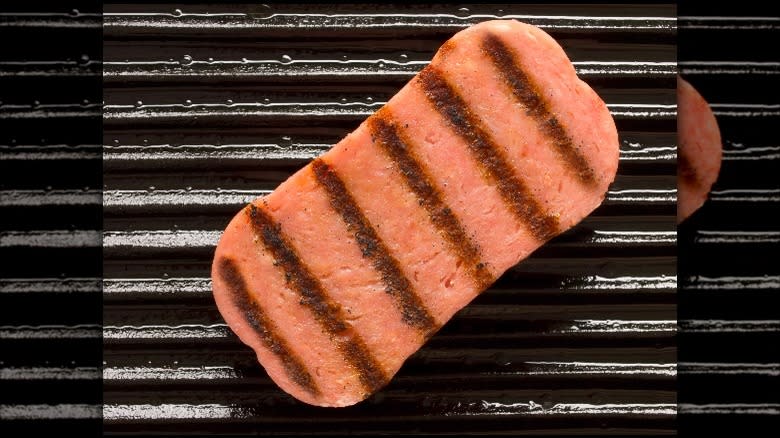
Frying Spam may be the most common way to cook it, but it's not the only way. You can also broil it in the oven, which is a great way to remove some of its fat content, or you can boil it to make it less salty and more creamy. Consider incorporating Spam into other recipes, like Spam corn or potato chowder. Why not explore Mexican food and try Spam tacos or "Spam-chiladas," which are, as you might guess, enchiladas made with Spam? You can even make monkey bread using the maple-flavored version of Spam.
The list of options goes on and on. You can put Spam in omelets, hashes, dips, or stir-fries. There are such things as Spam kabobs and Spamburgers (which just rolls off the tongue, doesn't it?). Then there's Spam pizza, which can be made just by adding small cubes of Spam to the top of your pizza before putting it in the oven. This one is especially popular in Hawaii, where the toppings list also includes pineapple chunks. Basically, if you have Spam, you can create a whole world of interesting dishes you may never have imagined before.
Mistake: Cooking Spam In The Can
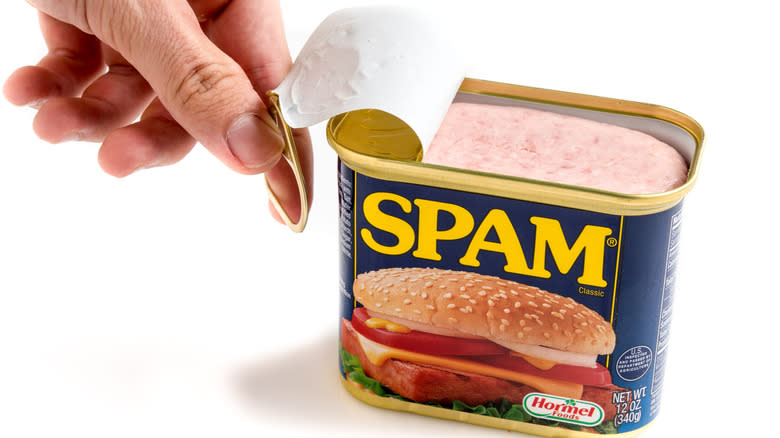
We wish we didn't have to tell you this, but the truth is, we do: Don't cook Spam when it's still in the can. Just don't do it. How could anyone possibly take this approach? Well, there's an urban legend going around that claims there's a really cool and easy way to cook Spam in the great outdoors without even opening the can. Simply bury it beneath the hot coals of your fire, and in a few minutes, you'll have perfectly cooked meat to eat straight from the can, like a cowboy.
As you might guess, this is not something anyone should ever attempt. Applying heat to a closed can causes the pressure inside to rise, which, as you might also guess, leads to an explosion. This can not only ruin your dinner, it can cause serious harm to you and whoever else is sitting around the campfire. There are a lot of great ways to cook Spam, but this is not one of them. So, if you're going to cook Spam on your next campout, please bring a pan with you too. Trust us, it's still cool.
Mistake: Thinking Spam Can Only Be Cooked At Dinnertime
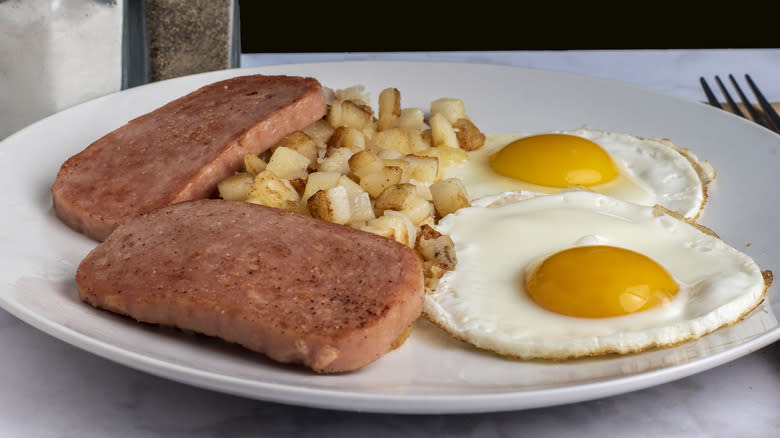
When many people see Spam, it's on a dinner plate. Whether it's fried or a part of another dish, that dish is usually being served as part of an evening meal. But if this is the only time you make Spam, you are seriously missing out.
Spam can make a great addition to the breakfast menu. You can add chunks of Spam to your scrambled eggs to make them heartier, sizzle up a plate of Spam breakfast hash, or get a bit more adventurous and make things like Spam pancakes, which are made by lightly cooking Spam slices on a griddle before pouring pancake batter over them and cooking them until the resulting pancakes are golden brown on both sides. You can also swap out the sausage or bacon in your breakfast sandwich to make a Spam and egg muffin, add Spam to a big ol' breakfast frittata, or wrap it in croissant dough to make Spam in a blanket. Since bacon, like Spam, is made from pork, it can work in many of the dishes bacon is typically added to, which makes swapping it out easy. This underutilized but delicious breakfast meat deserves a spot on your plate.
Mistake: Not Trying Musubi
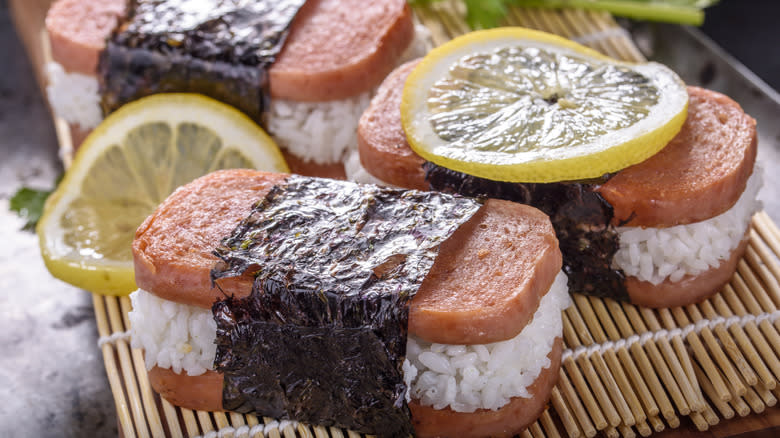
If you Google "Spam recipes," one of the most popular recommendations you'll get is Spam musubi. For those who have never heard of it before, musubi is a popular Hawaiian dish made of packed white rice topped with fish or meat, with seaweed wrapped around the middle. Spam is a hugely popular meat choice for musubi. Spam's popularity in Hawaii dates back to World War II, when U.S. troops were moved to the islands after the bombing of Pearl Harbor. Spam was in the soldiers' rations. Instead of eating it plain or straight from the can, people started to cut into slices and place it over blocks of rice. The resulting delicacy was so good that it is still widely enjoyed today.
To make your own musubi, slice up some Spam and cook it in the pan until it is crisp and brown. Then, using either a dedicated musubi press or just an empty Spam can lined with plastic, form a brick of cooked white rice, add other vegetables or sauces to taste, and top with a Spam slice. Remove everything from the mold/can and wrap a piece of seaweed around it, and you've got musubi. It's that easy!
Mistake: Not Realizing Spam Doesn't Actually Need To Be Cooked
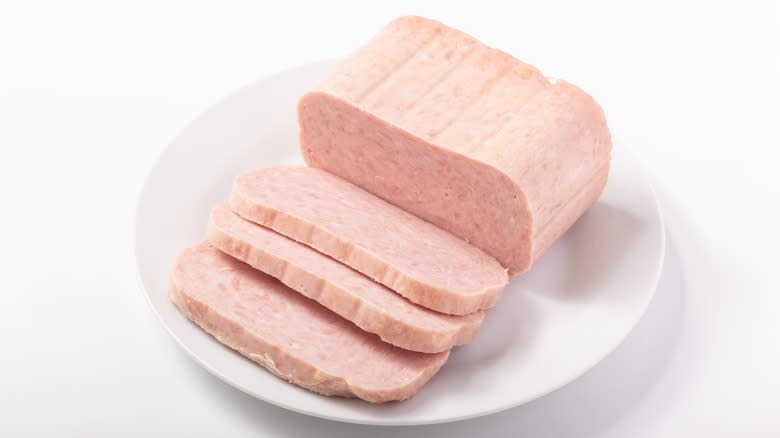
As you now know, there are many ways to cook Spam. But did you know that you can also eat it without cooking it at all? Spam is a processed meat, which means it has already been cooked. It is not, however, cooked in the way you might expect. Spam is made by blending pork shoulder and ham along with other ingredients like potato starch, salt, and water. Sodium nitrite is also used to preserve the meat. This mixture is put into a can. The can is then heated at a high temperature to make sure it is well-preserved and free of bacteria.
So, when you pop open that can of Spam, it's technically ready to eat. But ... you might not want to. Many people who have tried uncooked Spam say that its flavor is not very appealing, and neither is its consistency. For a better all-around Spam experience, you should probably cook it in one way or another. Still, it's good to know that it's safe to eat straight from the can if the spirit (or your hunger) moves you.
Read the original article on Daily Meal.

 Yahoo Finance
Yahoo Finance 